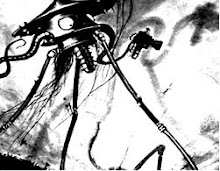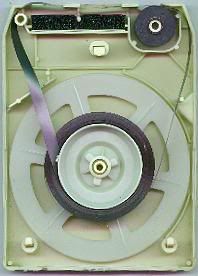A few months ago, the tape deck in my car broke (yes, I still make tapes from my records -- vinyl records, too) and I’ve been forced to listen to popular radio ever since when driving to and from work. Most of the time, I try to find something good on WABZ 100.7 “The Bay” or WBIG 100.3 “Big 100” (classic rock) since there is very little in contemporary rock that interests me. I haven’t always been successful, though, and I have been, on occasion, forced to turn to WWDC 101.1 FM “DC 101” and WIYY 97.9 FM “98 Rock” for my evening music fix -- which brings me to what prompted this study: the ridiculous amount of repetition on the two aforementioned stations.
The idea for this study had actually come to me earlier, but I didn’t have the time or the resources to be as thorough as I would have wanted. What follows is a very limited version of my idea, which I do hope to flesh out completely one day.
For this study, I listened to DC 101 and 98 Rock between the hours of 10:00 am and 12:00 pm. I would have preferred to listen during the evening rush hour (when I suspect that most people are listening to the radio), but that just wasn’t an option. Recording all the songs played on the two stations while I drove home from work didn’t seem feasible or very safe. I decided on the 10:00 am to 12:00 pm block because 10:00 am is the time that both stations end their morning-talk shows and play the first music of the day. I thought two hours would be a reasonable sample to get started with. But let me just say this now: my conclusions are in no way a representative sample in a scientific sense, and, therefore, they don’t say much in context of each station’s total programming. Further research would be required to draw those conclusions. But from what I have collected so far, I suspect that my hypothesis would hold true.
I recorded every single song played between 10:00 am and 12:00 pm, while also noting the artist, release date, and sub-genre (of rock) for each. I listened during weekday programming, beginning on Friday, March 30, 2007 and ending on Friday, April 6, 2007. I began this study to see if my initial hypothesis would be proved correct: that the top contemporary rock stations in the Baltimore/DC area play a smaller proportion of new music to back-catalogue, that these stations play many of the same bands and the same songs with little variation, and that there would be little diversity between the stations.
Before I get into the larger conclusions from the raw data, there was an interesting phenomenon that I noticed while listening to DC 101 and 98 Rock. On six separate occasions, the two radio stations played the same artist within minutes of each other:
| Date | Time | Station | Artist | Song |
| 4/2/2007 | 10:27 AM | 101.1 FM | Daughtry | It’s Not Over |
| 4/2/2007 | 10:31 AM | 97.9 FM | Daughtry | It’s Not Over |
| 4/2/2007 | 10:56 AM | 97.9 FM | Billy Idol | Dancing With Myself |
| 4/2/2007 | 10:58 AM | 101.1 FM | Billy Idol | White Wedding |
| 4/3/2007 | 10:36 AM | 97.9 FM | Green Day | She |
| 4/3/2007 | 10:38 AM | 101.1 FM | Green Day | American Idiot |
| 4/3/2007 | 10:58 AM | 101.1 FM | Offspring, The | The Kids Aren’t Alright |
| 4/3/2007 | 11:04 AM | 97.9 FM | Offspring, The | Gone Away |
| 4/4/2007 | 10:57 AM | 101.1 FM | Stone Temple Pilots | Unglued |
| 4/4/2007 | 11:00 AM | 97.9 FM | Stone Temple Pilots | Vasoline |
| 4/5/2007 | 11:17 AM | 101.1 FM | Nirvana | In Bloom |
| 4/5/2007 | 11:18 AM | 97.9 FM | Nirvana | In Bloom |
You’ll also notice that on two occasions, the same exact song is played on both stations. I noticed this before I started this limited study, and this is the kind of repetition I was expecting when I started recording data. I suspect that the instances of this type of occurrence only would increase as more data is collected.
Some general observations from the data: during this six day study, only 99 individual bands were heard and only 177 individual songs were played. That averages out to slightly less than two songs per band played. This doesn’t appear to be an especially diverse number of bands, considering that this study was conducted over 12 hours (720 minutes) of radio broadcasting. If we assume that the average rock song is about three or four minutes in length (we’ll assume an average song length of three and a half minutes for this exercise), and that each band has one song played during this time frame, the 99 bands only use up 346 and a half minutes. That’s only 48% of the total time monitored, meaning that these stations had enough time to play twice as many individual bands. This would be a considerable increase in the amount of diversity of each station.
To see just how limited the play lists are, take a look at the top 10 bands on each station:
98 Rock:
- Led Zeppelin
- Linkin Park
- Metallica
- My Chemical Romance
- Aerosmith
- Breaking Benjamin
- Bush
- Nirvana
- Red Hot Chili Peppers
- Stone Sour
The number of plays for these bands equal 37.8% of 98 Rock’s total programming for the time monitored. With a total of 59 individual bands played on 98 Rock during this time, this means that 10 bands (equaling only 17% of the total bands played) account for more than one-third of the total songs played.
DC 101:
- Green Day
- My Chemical Romance
- Three Days Grace
- Daughtry
- Stone Temple Pilots
- Fall Out Boy
- Incubus
- The Killers
- Linkin Park
- Modest Mouse
- Nirvana
- OK Go
- Pearl Jam
- Red Hot Chili Peppers
- White Stripes
(Note: DC 101 has 15 total bands in the top 10 because ranks 6-15 all have the same number of plays. Even if we end at rank 10, eliminating five bands that had an equal number of plays to bands ranked 6 and up, the top 10 accounts for 31.4% of total programming.)
The number of plays for these bands equals 46.3% of DC 101’s total programming for the time monitored. Considering that DC 101 played a total of 68 individual bands, the top bands account for 22% (or, only 14.7% if we only include up to rank 10) -- meaning that these 15 bands account for nearly half the total number of songs played.
Looking at the release date data, we see that each station plays a lot of back-catalogue compared to recent releases:

I defined “recent releases” as anything issued after January 1, 2006. Anything released before then was classified as back-catalogue. 98 Rock plays slightly more new music than DC 101.
For the sub-genre analysis, I grouped different sub-genres with similar roots/styles together and ended up with these groupings:
- Alternative Rock
- Hard Rock, Heavy Metal, Industrial Rock, Metal, and Rock
- Grunge and Pop-Punk
- Nu-Metal and Post-Grunge
- Garage Rock, Indie-Rock, New Wave, Post-Punk, Progressive Rock, Psychedelic Rock, Punk
- Other (which included Alternative Hip-Hop, Britpop, Dub, Folk Rock, Funk Rock, Hip-Hop, Reggae, Ska, and Southern Rock)
Here are the results, both stations’ data combined:

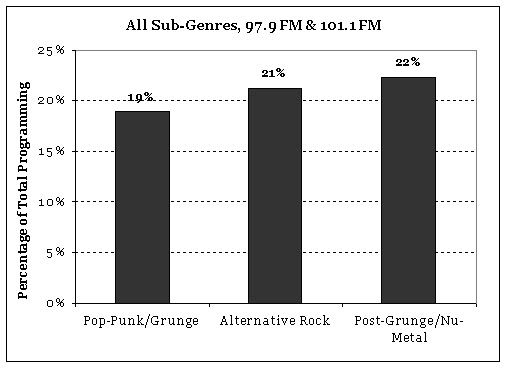
From this, we can see that songs fitting the Post-Grunge/Nu-Metal category are played the most often, with the broadly-defined Alternative Rock and Pop-Punk/Grunge categories close behind. This isn’t so surprising, considering the top three bands to be played on both stations:
| Rank | Artist | Number of Plays |
| 1 | My Chemical Romance | 11 |
| 2 | Green Day | 9 |
| Linkin Park |
| 3 | Daughtry | 8 |
| Nirvana |
| Red Hot Chili Peppers |
Breaking this down by station, we do see that there are differences in the frequency of the kinds of songs played, even if both stations are pulling from nearly the same pool of bands and songs:
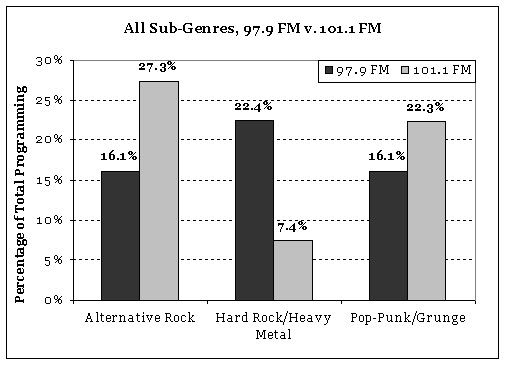
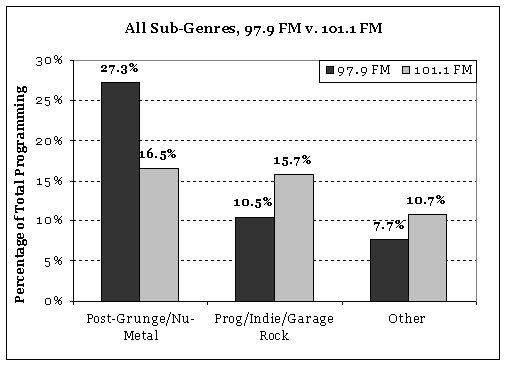
98 Rock is much more likely to play songs fitting the Post-Grunge/Nu-Metal and Hard Rock/Heavy Metal categories than DC 101. On the other hand, DC 101 is much more likely to play songs fitting the Alternative Rock and Pop-Punk/Grunge categories, as well as being more likely to play more artsy/underground styles (Prog/Indie/Garage Rock and Other categories).
So far, it appears that the two stations in question to have some diversity between each other, but the comparisons between the top 10 bands and sub-genres is a bit misleading in regards to this question. Looking at the total bands played, we see that there aren’t nearly enough bands that are exclusive to one station or the other.
To reiterate, 98 played a total of 59 individual bands. Only 31 of those bands were exclusive to that station, accounting for 52.5% of the total number of individual bands. DC 101 played a total of 68 individual bands. 40 of those bands were exclusive to DC 101, accounting for 58.8% of the total number of individual bands. This may seem like each station is pretty diverse in comparison to each other; however, when taken together it is apparent that each station’s play list is the same between 40% and 50% of the time. Considering the large volume of music available, this is strikingly higher than would be expected.
Finally, let’s compare Billboard.com’s top 20 modern rock tracks (issued 4/7/2007) to the number of plays each song received on each station:
| Rank | Artist | Song | 97.9 Plays | % | 101.1 Plays | % |
| 1 | Nine Inch Nails | Survivalism | 0 | 0 | 0 | 0 |
| 2 | 30 Seconds From Mars | From Yesterday | 2 | 1.4 | 1 | .83 |
| 3 | Breaking Benjamin | Breath | 4 | 2.8 | 1 | .83 |
| 4 | Incubus | Dig | 0 | 0 | 1 | .83 |
| 5 | Papa Roach | Forever | 3 | 2.1 | 0 | 0 |
| 6 | Modest Mouse | Dashboard | 0 | 0 | 0 | 0 |
| 7 | Three Days Grace | Pain | 0 | 0 | 1 | .83 |
| 8 | The Killers | Read My Mind | 0 | 0 | 2 | 1.65 |
| 9 | Silversun Pickups | Lazy Eye | 0 | 0 | 0 | 0 |
| 10 | My Chemical Romance | Famous Last Words | 6 | 4.2 | 0 | 0 |
| 11 | Rise Against | Prayer of the Refugee | 0 | 0 | 0 | 0 |
| 12 | The Red Jump Suit Apparatus | Face Down | 0 | 0 | 0 | 0 |
| 13 | Muse | Starlight | 0 | 0 | 2 | 1.65 |
| 14 | Red Hot Chili Peppers | Snow (Hey Oh) | 1 | .70 | 0 | 0 |
| 15 | Chevelle | Well Enough Alone | 0 | 0 | 0 | 0 |
| 16 | Plain White T’s | Hey There Delilah | 0 | 0 | 0 | 0 |
| 17 | Daughtry | It’s Not Over | 3 | 2.1 | 3 | 2.48 |
| 18 | Kaiser Chiefs | Ruby | 0 | 0 | 0 | 0 |
| 19 | AFI | The Missing Frame | 0 | 0 | 0 | 0 |
| 20 | Fall Out Boy | This Ain’t A Scene, It’s An Arms Race | 0 | 0 | 3 | 2.48 |
This data shows that 98 Rock and DC 101 played songs in the top 20 very rarely during the six days of the study. 98 Rock’s Billboard top 20 plays accounted for only 13.3% of all songs played, while DC 101’s Billboard top 20 plays accounted for only 11.6% of all songs played. While it may appear reassuring that the two aforementioned stations aren't just playing the most popular music all the time, this evidence also suggests that the two aforementioned stations play very little new music.
In summary, it appears that my hypothesis was only partially vindicated. The data did show that most of the music played on both stations is back-catalogue rather than new releases. Additionally, the data showed that the bands and songs played were very limited in their diversity; however, the data also showed that there is some diversity between the two stations themselves. I do suspect, though, that if I were able to conduct a more thorough study that the data would eventually show, unequivocally, that the two stations in question play a lot of the same music over and over again, with little variation between stations.






